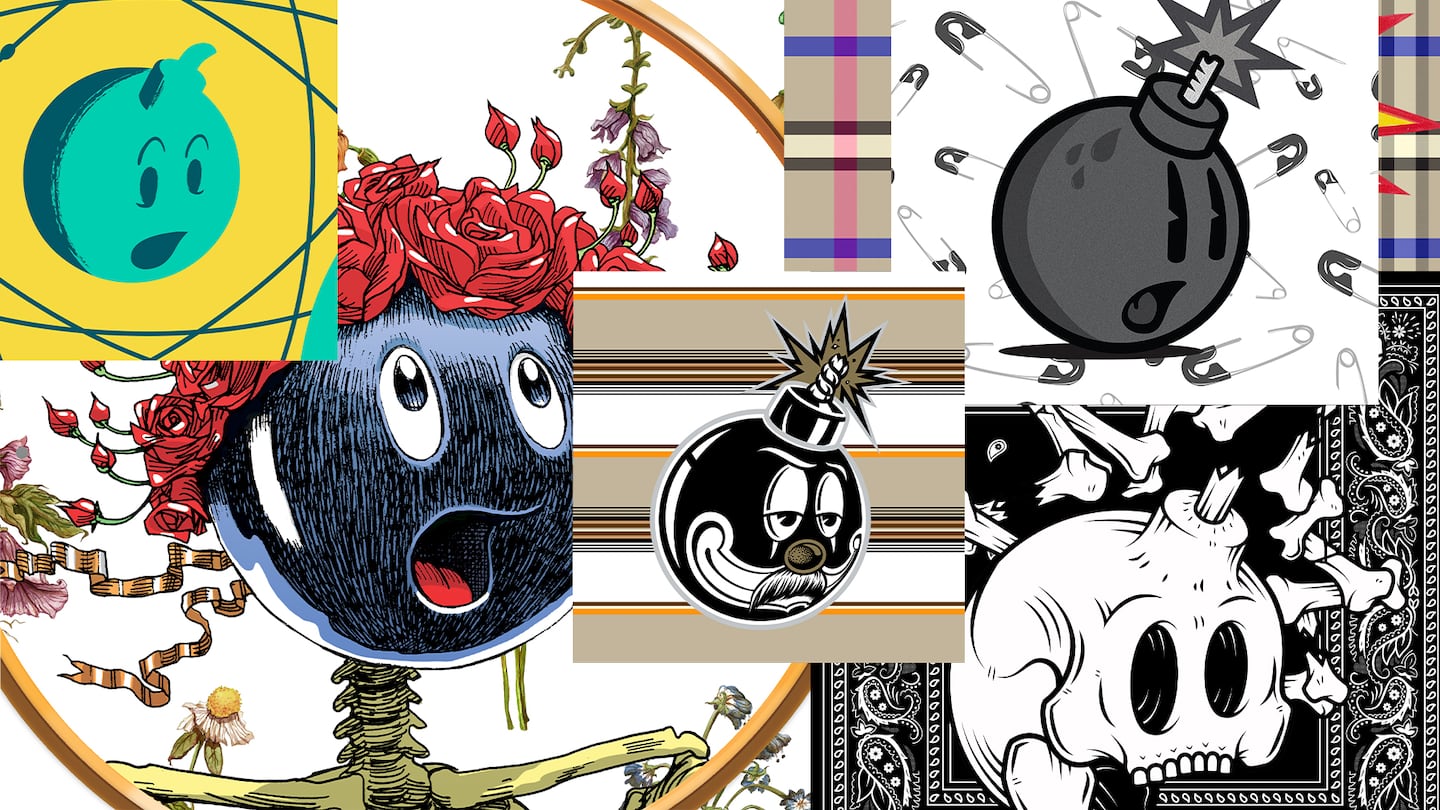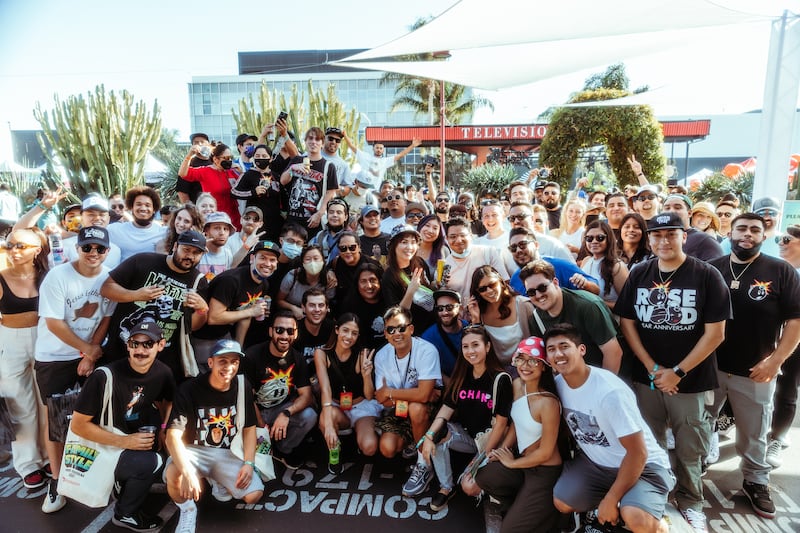
The Business of Fashion
Agenda-setting intelligence, analysis and advice for the global fashion community.

Agenda-setting intelligence, analysis and advice for the global fashion community.

 Opens in new window
Opens in new windowYou can’t say NFTs have no real-world applications. Over the past several months, holders of The Hundreds’ “Adam Bomb” NFTs have been getting tattoos of their bombs.
They depict the cartoon-bomb mascot of the Los Angeles-based streetwear label rendered in squiggly lines or leopard print, transformed into a skull or a strawberry or, in the case of one wearing a helmet, accessorised. Bobby Hundreds, the brand’s co-founder and creative director, has occasionally tweeted shots of the tattoos. Members of the Adam Bomb Squad, as holders of the 25,000 non-fungible tokens are known, are also making bomb-themed artwork and clothing, doing weekly hangouts on Twitter Spaces and organising meetups in real life, without The Hundreds’ involvement, he said.
The mood has been different at times among holders of Adidas’ “Into the Metaverse” NFTs. When Adidas first released them in December 2021 in collaboration with influential partners in the NFT space — Bored Ape Yacht Club, Punks Comic and the investor Gmoney — they quickly sold out, even at the cost of 0.2 ETH, or around $765 at the time. But after the initial excitement, holders gradually became restless in Adidas’ Discord channel as they waited for more details on the project’s “roadmap,” the term for the different utilities and benefits the NFTs will unlock in phases over time. Adidas has since revealed its plans, reassuring many members. It said in a statement that this is a new space for the company and it will continue to listen to and learn from its community.
The examples illustrate some of the promise and perils around NFTs as brands explore how to make them more than just collectables. The Hundreds, Adidas and Gucci are among those using them as a form of membership programme. Because NFTs can act as unique identifiers for their owners — similar to an email address but with added features because of the programmable smart contracts underlying them — brands can use them to extend holders privileges and perks, including freebies and exclusive access to new products.
ADVERTISEMENT
“What NFTs provide for our community is of course the social access,” Hundreds explained. “You feel like you’re a part of a club that other people aren’t privy to. Number two, there’s an actual utility in terms of token-gated product, so you have access to collections and collaborations and special product.”

But it’s not as simple as releasing some blockchain-backed jpegs. With NFTs still functioning as high-priced speculative assets, it can take work to keep customers satisfied. When Highsnobiety recently launched its own NFT studio, one of the motivations beyond releasing NFTs and providing support to brands was that it needed resources dedicated to managing these communities for itself and its clients, according to David Fischer, founder and chief executive.
“There’s a real expectation of course,” Fischer said, noting a $500 or $1,000 purchase for most buyers is not a trivial amount. Brands will talk about their roadmaps, he said, “but for the most part, after the mint it feels like the air flows out of the balloon.”
The financial motive is one of the tricky parts of using NFTs for loyalty. It can both keep a community invested but also centre it on the ability to profit. If NFTs remain expensive and difficult to buy, though, it limits the number of members who can participate.
Brands may also not want to run what amounts to an investment club where members are there because they’re pumping an asset. Hundreds himself acknowledged that amid the camaraderie that joins ABS holders there’s a shared desire to see their NFTs grow in worth.
Still, these brands are demonstrating there is a real way to integrate NFTs into a fashion business and make them more than an interesting sideshow for the industry.
Early Experiments
Gucci has rewarded holders of its NFTs by giving them a pass to buy NFTs from its collaboration with the project 10KTF, which comprised specially made Gucci outfits and accessories for the NFT profile pictures users are able to set on Twitter, Discord and likely Instagram soon, as Mark Zuckerberg, founder and chief executive of its parent company, Meta, revealed at SXSW. It has also invited them and a guest to an “IRL dance party with food and drinks” to take place on March 31 at a secret location in downtown LA.
ADVERTISEMENT
Adidas recently announced its NFT holders will get merchandise including a made-to-order tracksuit, as well as individual NFT profile pictures and freebies sent to their crypto wallets. It also said it’s looking into granting them exclusive access to sneaker drops in its Confirmed app.
“It very much feels like the future of membership,” Fischer said. “We’re almost looking at this as a membership programme on steroids, where you really get to super-serve your most loyal users and where NFTs become this point of access.”
NFTs still remain a sliver of these brands’ sales, however. Adidas issued 30,000 Into the Metaverse NFTs. That’s not a large membership programme for a brand that produced 340 million pairs of sneakers in 2021. Most NFT buyers still tend to be crypto enthusiasts who are more familiar than average customers with the often complicated mechanics of buying these items, which typically has to be done in cryptocurrency, and securing them in a crypto wallet.
“The biggest barrier of course is consumer adoption,” said Brian Walker, a veteran digital strategist and chief strategy officer at Bloomreach, a platform that provides companies tools to personalise their digital experiences. “I actually think what Gucci and Adidas are doing around NFTs is very interesting to watch. How far that scales and how meaningful that will be for a typical consumer I think is very questionable.”
Most brands probably won’t elicit the kind of loyalty that convinces their NFT holders to get tattoos. The Hundreds released its NFTs in August 2021, right around the peak of last year’s surge in sales, making it one of fashion’s earliest entrants into the space. The rising prices helped forge a sense of loyalty among those who bought in early. By January 2022, even Shopify had bought an Adam Bomb. On Twitter, some ABS members talked about getting tattoos only if their NFTs hit a certain value.
Even for The Hundreds, though, it hasn’t translated directly into a boom in sales of physical product.
“We are seeing uptick in sales, but it’s not significant to where I’d be like, ‘Everyone should start this and it’s a good marketing ploy,’” Hundreds said. “It’s not.”
The Future of Loyalty
ADVERTISEMENT
The Hundreds’ NFT program has been successful in large part because it has created a genuine sense of shared ownership with ABS members. Earlier this year, the brand started issuing them royalties on sales when it uses their bombs in products. For now, that means store credit to spend with the brand, Hundreds said, to avoid running afoul of securities regulations.
The move is in keeping with the ethos of web3, an envisioned evolution of the internet toward a decentralised, blockchain-based architecture that theoretically promotes collective ownership. Yuga Labs, creator of the highly successful Bored Ape Yacht Club brand, grants commercialisation rights to Bored Ape holders, and it gave the same rights to owners of CryptoPunks and Meebits NFTs after acquiring those collections.
Fashion brands that closely guard their intellectual property and employ legal teams for the purpose may not want to follow that model. Though brands could also issue their own crypto coins, as Scott Galloway, a digital strategy and marketing expert at NYU’s Stern school, recently hypothesised in a talk at SXSW. If Chanel issued a limited number of coins whose ownership conferred exclusive rewards, it could deepen loyalty among holders and become valuable assets themselves, he speculated.
Maybe the more likely future is that NFT prices will moderate and brands will use them much like current loyalty programs with additional features.
Whatever the case, Hundreds said his hope is that in 10 years people are still holding their Adam Bomb Squad NFTs, and that The Hundreds is still rewarding them.
Both trade in heavily hyped, limited-edition products that offer a sense of community. Fashion brands aiming to tap digital art take note.
The swelling ranks of the crypto-rich are boosting US luxury sales, and unlike previous generations of tech wealth, many are splashing out large sums on fashion that gets them noticed.
Nike, Adidas and other big brands have plunged headlong into the latest crypto craze. But companies and their customers may soon discover converting virtual fashion into real-world profits isn’t so easy. Caveat emptor, says The NPD Group’s Matt Powell.

Marc Bain is Technology Correspondent at The Business of Fashion. He is based in New York and drives BoF’s coverage of technology and innovation, from start-ups to Big Tech.
TikTok’s first time sponsoring the glitzy event comes just as the US effectively deemed the company a national security threat under its current ownership, raising complications for Condé Nast and the gala’s other organisers.
BoF Careers provides essential sector insights for fashion's technology and e-commerce professionals this month, to help you decode fashion’s commercial and creative landscape.
The algorithms TikTok relies on for its operations are deemed core to ByteDance overall operations, which would make a sale of the app with algorithms highly unlikely.
The app, owned by TikTok parent company ByteDance, has been promising to help emerging US labels get started selling in China at the same time that TikTok stares down a ban by the US for its ties to China.